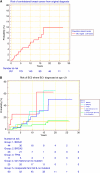Long-term outcomes of breast cancer in women aged 30 years or younger, based on family history, pathology and BRCA1/BRCA2/TP53 status
- PMID: 20234365
- PMCID: PMC2853095
- DOI: 10.1038/sj.bjc.6605606
Long-term outcomes of breast cancer in women aged 30 years or younger, based on family history, pathology and BRCA1/BRCA2/TP53 status
Abstract
Background: There are relatively few articles addressing long-term follow-up in women with breast cancer at very young ages.
Methods: We have updated and extended our population-based analysis of breast cancer diagnosed at the age < or =30 years in North-west England to include an extra 15 patients with mutation testing in BRCA1, BRCA2 and TP53, with 115 of 288 consecutive cases being tested. Kaplan-Meier curves were generated to assess overall survival, contralateral breast cancer and other second primaries.
Results: Survival analysis of all 288 patients showed poor overall survival, although this improved from a 15-year survival of only 46% in those diagnosed between 1980 and 1989 to 58% in those diagnosed between 1990 and 1997 (P=0.05). Contralateral breast cancer rates were at a steady rate of 0.6 per 1000, although the rates in mutation carriers were approximately 2 per 1000. Altogether, 16 BRCA1, 9 BRCA2 and 6 TP53 mutations have now been found among the 115 cases on whom DNA analysis has been performed. BRCAPRO accurately predicted the number of carriers for BRCA1 and BRCA2 and was sensitive and specific at the 10 and 20% threshold, respectively. However, BRCAPRO did not seem to give any weight to DCIS, which accounted for two BRCA1 carriers and three TP53 carriers and overpredicted mutations at the high end of the spectrum, with only 6 of 11 (54%) with a >90% probability having identifiable BRCA1/2 mutations.
Interpretation: Rates of new primaries are predicted to some extent by mutation status. BRCAPRO is useful at determining those patients aged < or =30 years to be tested.
Figures


Similar articles
-
Spectrum of mutations in BRCA1, BRCA2, CHEK2, and TP53 in families at high risk of breast cancer.JAMA. 2006 Mar 22;295(12):1379-88. doi: 10.1001/jama.295.12.1379. JAMA. 2006. PMID: 16551709
-
BRCAPRO validation, sensitivity of genetic testing of BRCA1/BRCA2, and prevalence of other breast cancer susceptibility genes.J Clin Oncol. 2002 Jun 1;20(11):2701-12. doi: 10.1200/JCO.2002.05.121. J Clin Oncol. 2002. PMID: 12039933
-
BRCA1 and BRCA2 mutation predictions using the BOADICEA and BRCAPRO models and penetrance estimation in high-risk French-Canadian families.Breast Cancer Res. 2006;8(1):R3. doi: 10.1186/bcr1365. Epub 2005 Dec 12. Breast Cancer Res. 2006. PMID: 16417652 Free PMC article.
-
Prevention of breast cancer in women who carry BRCA1 or BRCA2 mutations: a critical review of the literature.Int J Cancer. 2004 Nov 10;112(3):357-64. doi: 10.1002/ijc.20429. Int J Cancer. 2004. PMID: 15382059 Review.
-
Familial breast cancer.Clin Genet. 2012 Aug;82(2):105-14. doi: 10.1111/j.1399-0004.2012.01859.x. Epub 2012 Apr 13. Clin Genet. 2012. PMID: 22356477 Review.
Cited by
-
Risk of contralateral breast cancer in BRCA1 and BRCA2 mutation carriers: a 30-year semi-prospective analysis.Fam Cancer. 2015 Dec;14(4):531-8. doi: 10.1007/s10689-015-9825-9. Fam Cancer. 2015. PMID: 26239694
-
Germline TP53 Testing in Breast Cancers: Why, When and How?Cancers (Basel). 2020 Dec 14;12(12):3762. doi: 10.3390/cancers12123762. Cancers (Basel). 2020. PMID: 33327514 Free PMC article. Review.
-
The Manchester guidelines for contralateral risk-reducing mastectomy.World J Surg Oncol. 2015 Aug 7;13:237. doi: 10.1186/s12957-015-0638-y. World J Surg Oncol. 2015. PMID: 26245209 Free PMC article.
-
Extended gene panel testing in lobular breast cancer.Fam Cancer. 2022 Apr;21(2):129-136. doi: 10.1007/s10689-021-00241-5. Epub 2021 Mar 25. Fam Cancer. 2022. PMID: 33763779 Free PMC article.
-
Next generation sequencing is informing phenotype: a TP53 example.Fam Cancer. 2018 Jan;17(1):123-128. doi: 10.1007/s10689-017-0002-1. Fam Cancer. 2018. PMID: 28509937
References
-
- Anders CK, Hsu DS, Broadwater G, Acharya CR, Foekens JA, Zhang Y, Wang Y, Marcom PK, Marks JR, Febbo PG, Nevins JR, Potti A, Blackwell KL (2008) Young age at diagnosis correlates with worse prognosis and defines a subset of breast cancers with shared patterns of gene expression. J Clin Oncol 26(20): 3324–3330 - PubMed
-
- Antoniou AC, Cunningham AP, Peto J, Evans DG, Lalloo F, Narod SA, Risch HA, Eyfjord JE, Hopper JL, Southey MC, Olsson H, Johannsson O, Borg A, Passini B, Radice P, Manoukian S, Eccles DM, Tang N, Olah E, Anton-Culver H, Warner E, Lubinski J, Gronwald J, Gorski B, Tryggvadottir L, Syrjakoski K, Kallioniemi OP, Eerola H, Nevanlinna H, Pharoah PD, Easton DF (2008) The BOADICEA model of genetic susceptibility to breast and ovarian cancers: updates and extensions. Br J Cancer 45(7): 425–431 - PMC - PubMed
-
- Bergfeldt K, Rydh B, Granath F, Grönberg H, Thalib L, Adami HO, Hall P (2002) Risk of ovarian cancer in breast-cancer patients with a family history of breast or ovarian cancer: a population-based cohort study. Lancet 360(9337): 891–894 - PubMed
-
- Birch JM, Hartley AL, Tricker KJ, Prosser J, Condie A, Kelsey AM, Harris M, Morris-Jones PH, Crowther D, Craft AW, Eden OB, Evans DGR, Thompson E, Mann J, Martin J, Mitchell ELD, Santibanez-Koref MF (1994) Prevalence and diversity of constitutional mutations in the p53 gene among 21 Li-Fraumeni families. Cancer Res 54: 1298–1304 - PubMed
Publication types
MeSH terms
LinkOut - more resources
Full Text Sources
Medical
Research Materials
Miscellaneous

